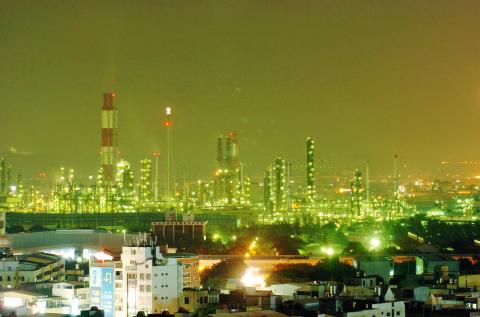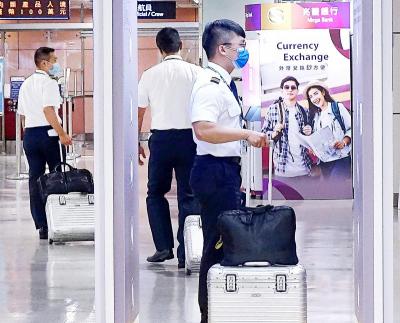Greater Kaohsiung has served as a hub for the petrochemical industry since the Japanese colonial era.
The city’s local industry employs 35,000 workers and is home to multiple petrochemical parks such as the state-run CPC Corp, Taiwan’s (CPC) Kaohsiung Refinery Plant, its Dalin (大林) Township Refinery Plant, the Dafa Industrial Area, the Linyuan (林園) Petrochemical Area, the Renwu (仁武) Petrochemical Industial Area and the Dashe (大社) Petrochemical Industrial Area.
The beginnings of the municipality’s petrochemical industry can be traced to 1936, when the former Japanese Imperial Navy established a fuel plant in what is now Nanzih District’s (楠梓) Houjin Township (後勁) to refine crude oil and fuel its fleet.

Photo: Chang Chung-yi, Taipei Time
After World War II ended in 1946, the then-Chinese Nationalist Party (KMT) government took over the plant, expanded on the Japanese-built infrastructure and refashioned it into CPC’s Kaohsiung fuel refinery.
In 1971, the plant expanded to include CPC’s first and second naphtha crackers, prompting other petrochemical giants to also set up facilities near Kaohsiung in Renwu and Dashe districts. Companies that have invested in these areas include the Formosa Plastics Group, Nanya Technology, USI Corp, Asia Polymer Corp, Taita Chemical Co and China Petrochemical Development Corp.
Currently, CPC’s Kaohsiung fuel refinery has 1,700 employees and churns out 200,000 barrels of oil a day.
However, its fifth naphtha cracker is facing an impending relocation and has been trying to boost its production quota to compensate for the period when it will not be operating during the move. The Renda (仁大) Industrial Area and more than 10 companies are to be impacted by the relocation, which could cost 2,500 workers their jobs.
The concentration of the petro-chemical industry in Greater Kaohsiung has prompted the saying: “If anything explodes at CPC’s plant, it would level Kaohsiung.”
However, prior to the pipeline explosions in the city’s Cianjhen (前鎮) and Lingya (苓雅) districts late on Thursday night and early on Friday morning, the expression had been said only in jest.
After seeing how a propene leak in a pipeline running underneath the middle of those districts wreaked massive damage, civic groups and academics are beginning to worry about Greater Kaohsiung’s status as a petrochemical hub.
As of 4pm yesterday, 28 people, including four firefighters, have been confirmed dead in the blasts, with two firemen still missing and 302 people reported as injured, according to figures compiled by the Central Disaster Emergency Operation Center.
Citizen of the Earth, Taiwan executive director Lee Ken-cheng (李根政) said that the network of pipes carrying petrochemical substances under the city is too dense, adding that some pipelines were even connected to one other.
After four decades in use, the pipes are all outdated, making them akin to dud bombs, Lee said.
Chang Jui-ren (張瑞仁), director of the Professional Geotechnical Engineers Association’s Kaohsiung-Pingtung Office, said the gas companies should have been more worried than the government about leaks depressurizing the flow of gas, adding that no one had a clue about which pipe was malfunctioning.
“How can the public feel safe with these people in charge of the pipelines running underneath them?” Chang asked.
Yang Ping-tsang (楊秉蒼), a professor at Cheng Shiu University’s department of civil engineering, said the problem lay in the nation’s lack of laws governing the oversight of pipelines’ security, so local governments build modern urban cities with no visible pipelines by putting them underground, which means no one knows what state they are in.
Former Kaohsiung Professional Civil Engineers Association president Ou Liang-kui (歐良規) said that despite recent fears, the continued security and transformation Greater Kaohsiung must not exclude the petrochemical industry.
The Greater Kaohsiung City Government’s plan for the “New Asia Bay Area” happens to pass over Chenggong Road, under which run oil and petrochemical pipelines, Ou said.
If anything were to happen to that line, the “cream of the cream” of Greater Kaohsiung may be subject to explosion, Ou said.
Though the petrochemical industry provides for tens of thousands of families, a recent string of safety incidents including the blasts led the director of the city government’s Economic Development Bureau, Tseng Wen-sheng (曾文生), to say that while the city welcomes investors, it also hopes they will uphold their social responsibilities.

Three Taiwanese airlines have prohibited passengers from packing Bluetooth earbuds and their charger cases in checked luggage. EVA Air and Uni Air said that Bluetooth earbuds and charger cases are categorized as portable electronic devices, which should be switched off if they are placed in checked luggage based on international aviation safety regulations. They must not be in standby or sleep mode. However, as charging would continue when earbuds are placed in the charger cases, which would contravene international aviation regulations, their cases must be carried as hand luggage, they said. Tigerair Taiwan said that earbud charger cases are equipped

Foreign travelers entering Taiwan on a short layover via Taiwan Taoyuan International Airport are receiving NT$600 gift vouchers from yesterday, the Tourism Administration said, adding that it hopes the incentive would boost tourism consumption at the airport. The program, which allows travelers holding non-Taiwan passports who enter the country during a layover of up to 24 hours to claim a voucher, aims to promote attractions at the airport, the agency said in a statement on Friday. To participate, travelers must sign up on the campaign Web site, the agency said. They can then present their passport and boarding pass for their connecting international

UNILATERAL MOVES: Officials have raised concerns that Beijing could try to exert economic control over Kinmen in a key development plan next year The Civil Aviation Administration (CAA) yesterday said that China has so far failed to provide any information about a new airport expected to open next year that is less than 10km from a Taiwanese airport, raising flight safety concerns. Xiamen Xiangan International Airport is only about 3km at its closest point from the islands in Kinmen County — the scene of on-off fighting during the Cold War — and construction work can be seen and heard clearly from the Taiwan side. In a written statement sent to Reuters, the CAA said that airports close to each other need detailed advanced

The age requirement for commercial pilots and airline transport pilots is to be lowered by two years, to 18 and 21 years respectively, to expand the pool of pilots in accordance with international standards, the Ministry of Transportation and Communications announced today. The changes are part of amendments to articles 93, 119 and 121 of the Regulations Governing Licenses and Ratings for Airmen (航空人員檢定給證管理規則). The amendments take into account age requirements for aviation personnel certification in the Convention on International Civil Aviation and EU’s aviation safety regulations, as well as the practical needs of managing aviation personnel licensing, the ministry said. The ministry